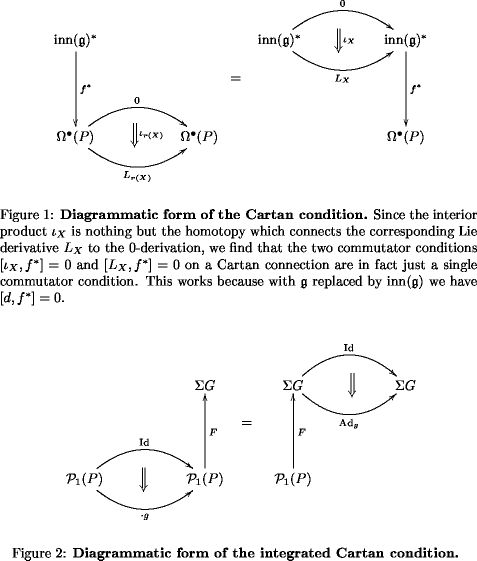What is a Lie Derivative, really?
Posted by Urs Schreiber
For solving the problem that I am currently working on, it turned out I need to understand
What is a Lie derivative, really?
By which I mean
What is a Lie derivative, arrow-theoretically?
By which I mean
How can I think of a Lie derivative in an implementation-independent way, such that the concept may be a) internalized and, in particular, b) be categorified without effort (read: without running into problems that require thinking).
As David Corfield has put it in The Two Cultures of Mathematics Revisited:
“[…] for any worthwhile idea there is a story about it which gets to the heart of what it really is, and I’ll know when I’ve reached that point by the ease with which it categorifies.”
And this may be necessary for understanding what’s going on.
So here is my current take at the answer to “What is a Lie derivative, really?”. It’s maybe not quite the final answer yet, but the applications that I am looking at suggest that this is on the right track.
Let me know what you think!
Question: What is a Lie derivative really?
Answer (somewhat preliminary): For any given object in a ()-category, Lie derivatives on are 2-morphisms starting at the identity morphism These compose using horizontal composition of transformations.
Examples:
1) ordinary Lie derivatives: Let be the differential graded commutative algebra of differential forms on a manifold . This is an object in an -category (I think) whose morphisms are degree 0-derivations, whose 2-morphisms are chain homotopies of these (hence in particular degree -1 derivations), etc.
Then a Lie derivative as a above is a chain homotopy (contraction with vector field )
2) the integrated version of that
The above example may be regarded as the Lie algebroid version of the following groupoid situation:
Let be the path groupoid of (morphisms are thin-homotopy classes of paths in ).
In Isham on Arrow Fields I reviewed the discussion of From Arrows to Disks later extended to The Algebra of Observables, that flows along vector fields on should arrow-theoretically be thought of as transformations: Here, more precisely, the flow is a smooth Lie group homomorphism from the additive group of real numbers to the group of of transformations under horizontal composition as above.
2) the puzzle posed in Derivation Lie 1-Algebras of Lie -Algebras:
Every Lie -algebra can equivalently be conceived as a free graded commutative algebra with a differential on it (described here).
This means we have the Lie derivatives for each degree -1 derivation on .
I was asking for the integrated version of this. Following this argument I am pretty sure (but still haven’t tried to fully prove this in all detail), that for a Lie -group integrating , the corresponding Lie group is that of the transformations
There is a story to be told how these three examples taken together help to find the answer to
What is a Cartan connection, really?
Answering this solves the problem
What is a -connection , for any Lie -algebra?
But that story will be told elsehere.


Re: What is a Lie derivative, really?
This is really interesting Urs! I think I’m starting…slowly… to understand what you and Jim Stasheff have been talking about.